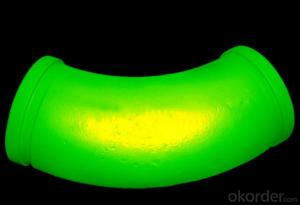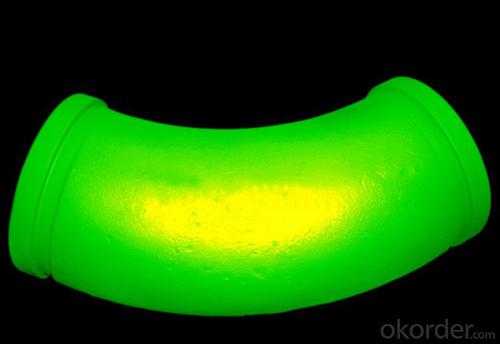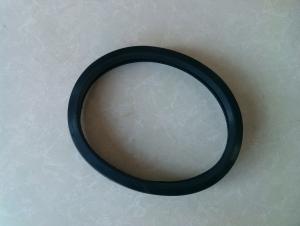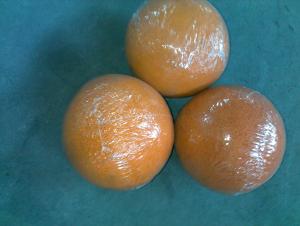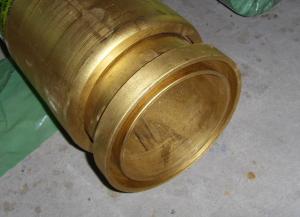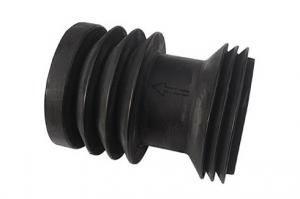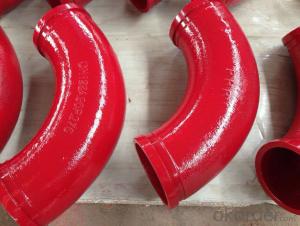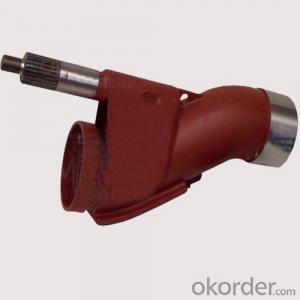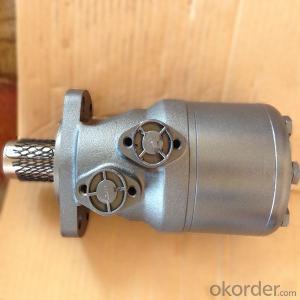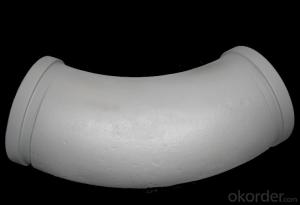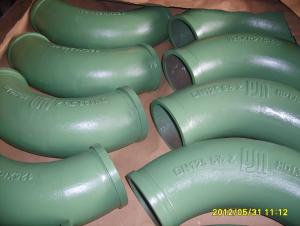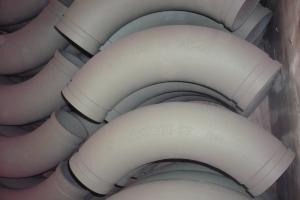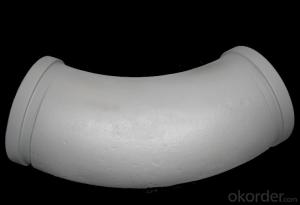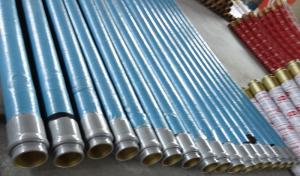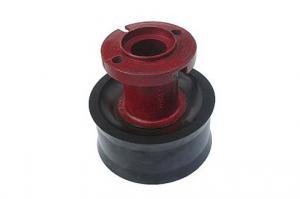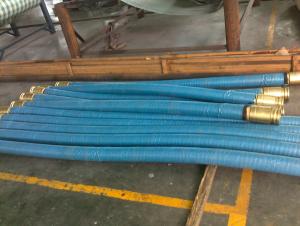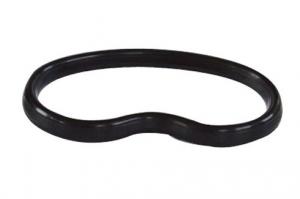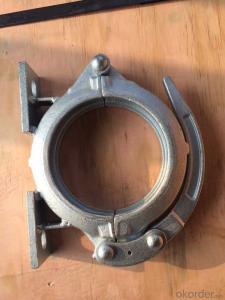Concrete Pump ELBOW R275, 45DGR DN125MM Green with High Quality
- Loading Port:
- Tianjin
- Payment Terms:
- TT or LC
- Min Order Qty:
- 10 pc
- Supply Capability:
- 5000 pc/month
OKorder Service Pledge
OKorder Financial Service
You Might Also Like
Product Name: Concrete Pump ELBOW R275, 45DGR DN125MM
1. Specification
Dimensions: DN125MM
Radius: 275mm,45DGR
Flange: SK, ZX, F&M
Degree: 30°, 45°, 90°
Material: #20 steel, ST52, Mn 13-4
Thickness: 4.5mm,6mm,7.1mm,7.5mm,10mm,
Working pressure: 180MPa
Notes: total series of concrete pump clamp for different brand concrete pump(PUTZMEISTER, SCHWING, CIFA, SANY, ZOOMLION, IHI, KYOKUTO Etc) available from us.
2. Application of Concrete Pump Bend DN125
Concrete Pump ELBOW R275, 45DGR DN125MM widely used on concrete pump truck, concrete placing boom, trailer concrete pump etc, for concrete delivery pipe connection.
Our concrete pump bends have been successfully exported to many countries from 1998, Our main markets as below: Middle East, Southeast Asia, America, Brazil, Italy, Russia, South Africa etc
Aiming at the largest concrete pump parts manufacturer, and reliable, professional supplier in China, we can supply concrete pump elbows, delivery pipes, casting or forging couplings, end rubber hoses, rubber pistons, tungsten wear plates, delivery cylinders, and other hydraulic parts, one stop service for your concrete pump parts and accessory business.
3. Package and Delivery of Concrete Pump Bends
Every 60pcs Concrete Pump Bend DN125 put in one seaworthy wooden box, and 20 boxes in one 20feet container.
FAQ:
Q1: Why buy Materials & Equipment from OKorder.com?
A1: All products have its ISO certifications, adheres to the highest standards and a commitment to supply chain safety and customer satisfaction.
Q2: How do we guarantee the quality of our products?
A2: We have established an advanced quality management system which conducts strict quality tests at every step, from raw materials to the final product. At the same time, we provide extensive follow-up service assurances as required.
Q3: How soon can we receive the product after purchase?
A3: Within three days of placing an order, we will begin production. The specific shipping date is dependent upon international and government factors, but is typically 10 to 30 workdays.
Q4: If we can produce some Concrete Pump ELBOW R275, 45DGR DN125MM according to customers request?
A4: Yes, we can produce Concrete Pump ELBOW R275, 45DGR DN125MM according to the difference country situations and different concrete pump to make it suitable to the market and customers. We have very professional technical team to make the design.
Q5: How to make a quick resolution for after service?
A5:We have overseas branches all-around of world, IF needed, the seller shall dispatch 2 engineers to the buyer's site for supervision of training. The buyer shall make available of necessary facilities &skilled personnel at site for training.
Images:
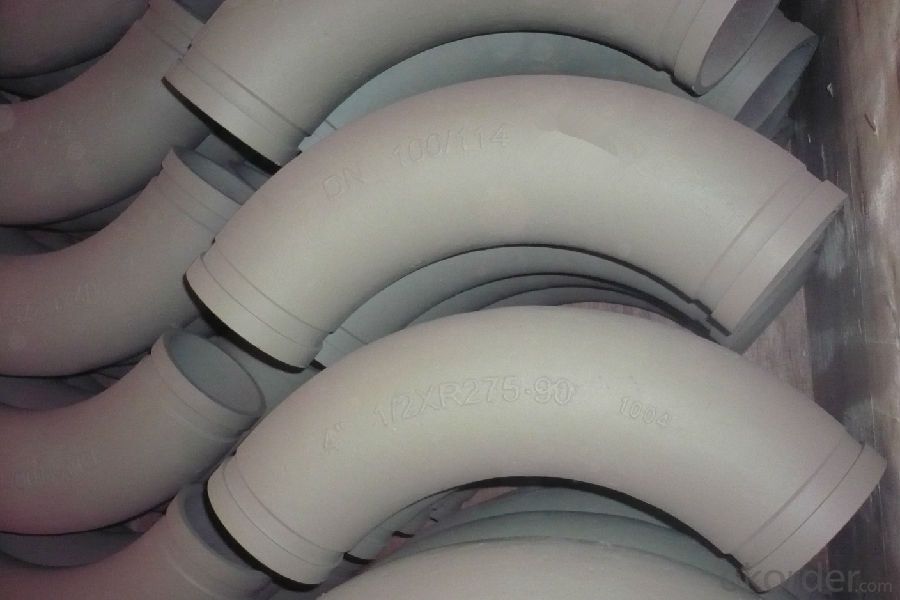
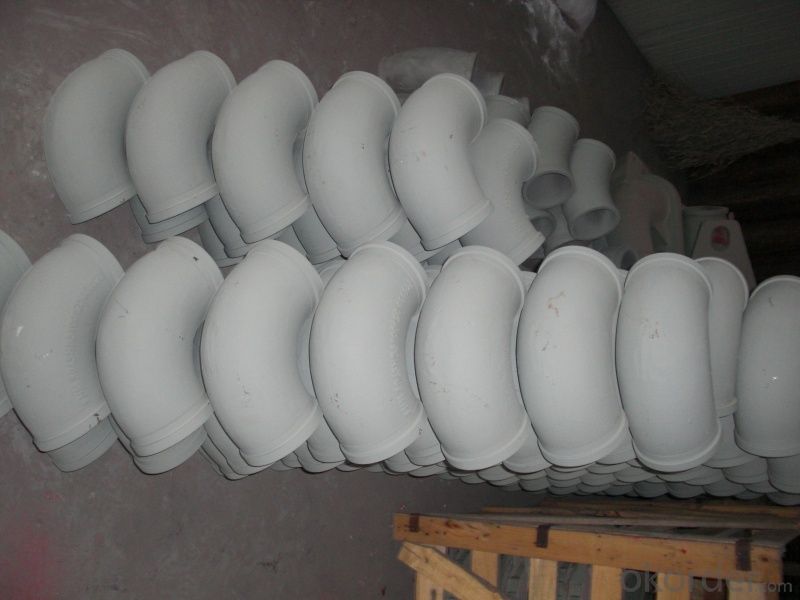
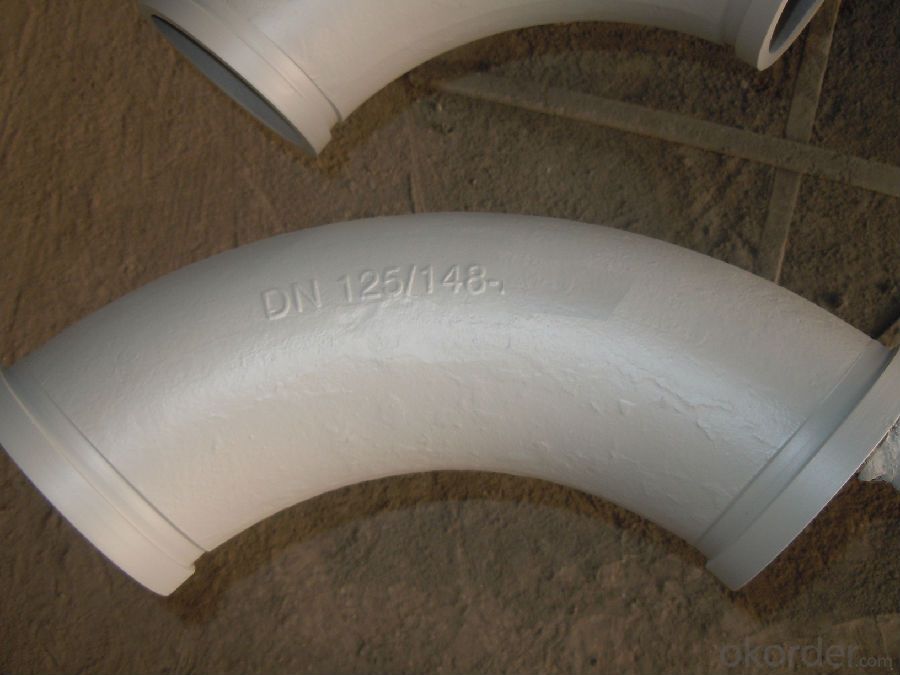
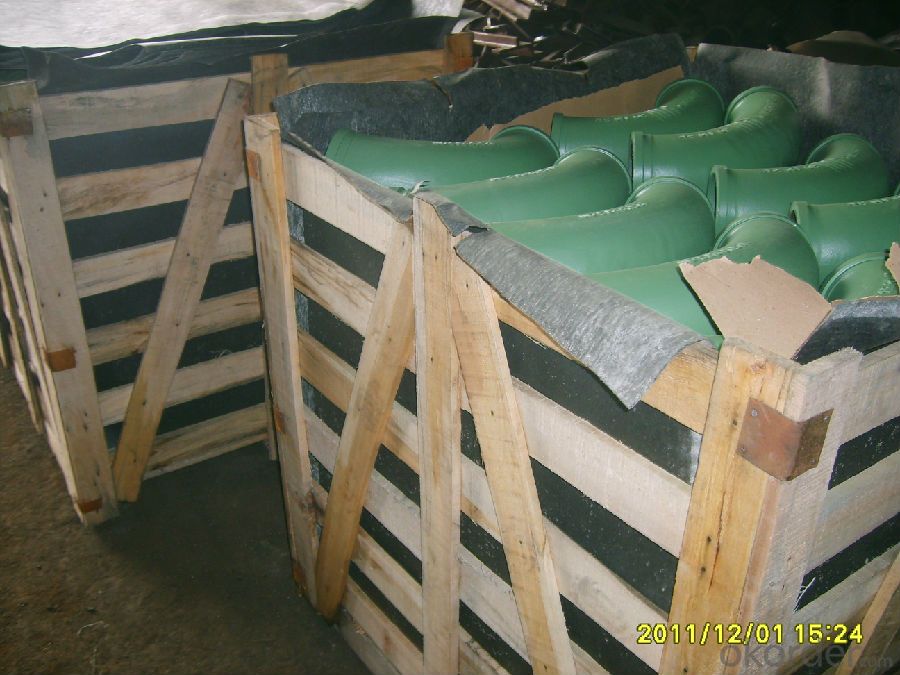
- Q: What are the advantages of using pre-assembled spare parts for concrete pumps?
- There are several advantages of using pre-assembled spare parts for concrete pumps. Firstly, pre-assembled spare parts ensure a quick and efficient replacement process. Since these parts are already assembled, they can be easily installed without any additional time or effort required for assembly. This helps to minimize downtime and maximize productivity on construction sites, as the concrete pump can be quickly repaired and put back into operation. Secondly, using pre-assembled spare parts guarantees a high level of quality and compatibility. These parts are manufactured by the original equipment manufacturer (OEM) or authorized suppliers, ensuring that they meet the required standards and specifications. By using genuine pre-assembled parts, the performance and longevity of the concrete pump are maintained, reducing the risk of malfunctions or breakdowns. Another advantage is the cost-effectiveness of pre-assembled spare parts. While the initial cost of these parts may be slightly higher than individual components, they often prove to be more cost-effective in the long run. By purchasing pre-assembled parts, construction companies can avoid the additional costs associated with assembly, such as labor and time. Additionally, using high-quality pre-assembled parts reduces the need for frequent replacements and repairs, saving money on maintenance and downtime expenses. Furthermore, pre-assembled spare parts offer convenience and reliability. Construction projects often have tight deadlines, and any delays can be costly. By having pre-assembled spare parts readily available, construction teams can quickly respond to any breakdowns or failures, minimizing disruptions to the project timeline. Additionally, the reliability of these parts ensures that the concrete pump will operate consistently and efficiently, reducing the risk of unexpected issues on the construction site. In conclusion, the advantages of using pre-assembled spare parts for concrete pumps include quick and efficient replacement, high quality and compatibility, cost-effectiveness, and convenience and reliability. By adopting these pre-assembled parts, construction companies can ensure smooth operations, minimize downtime, and maximize productivity on their projects.
- Q: Which is the best home made concrete pump car?
- The first line is 31 and Zhonglian, the price is expensive, the car is big, the problem is not, and there are many small problems
- Q: How often should concrete pump pressure gauges be inspected and replaced?
- Concrete pump pressure gauges should be inspected and replaced on a regular basis, ideally every six months or as recommended by the manufacturer. Regular inspections help ensure accurate pressure readings and prevent potential accidents or malfunctions due to faulty gauges.
- Q: Are there any specific cleaning procedures for concrete pump spare parts?
- Concrete pump spare parts have specific cleaning procedures that must be followed to maintain their efficiency and longevity. It is crucial to ensure that these parts are clean and free from any dirt or debris. Here are some general guidelines to consider when cleaning concrete pump spare parts: 1. Prioritize Safety: Before initiating the cleaning process, ensure that you are wearing appropriate personal protective equipment (PPE), such as gloves and safety goggles, to protect yourself from potential hazards. 2. Disconnect Power: Before cleaning any electrical or mechanical parts, make sure to disconnect the power supply to prevent accidents. 3. Eliminate Excess Dirt: Employ a brush or dry cloth to eliminate any loose dirt or debris from the surface of the spare parts. This action will enhance the effectiveness of the cleaning process. 4. Utilize Suitable Cleaning Solution: Select an appropriate cleaning solution based on the type of spare parts and the level of dirt. Mild detergents or soapy water are generally safe to use, while harsh chemicals or solvents should be avoided to prevent damage to the parts. 5. Scrub and Rinse: Dip a clean cloth or sponge into the cleaning solution and gently scrub the spare parts to remove stubborn dirt or stains. Thoroughly rinse the parts with clean water to eliminate any residue from the cleaning solution. 6. Complete Drying: After rinsing, make sure to completely dry the spare parts using a clean cloth or by air-drying. Moisture can lead to rust or corrosion, so ensuring thorough drying is essential. 7. Lubricate Moving Parts: Apply an appropriate lubricant to any moving components, such as bearings or gears, to ensure smooth operation. This will help prevent wear and tear and extend the lifespan of the parts. 8. Regular Maintenance: To maintain the optimal condition of the concrete pump spare parts, it is recommended to perform regular cleaning and maintenance. Periodically inspect them for any signs of damage or wear and replace them if necessary. By adhering to these specific cleaning procedures, you can effectively clean and maintain the concrete pump spare parts, guaranteeing their reliability and longevity.
- Q: Can concrete pump valves be repaired or should they be replaced?
- Concrete pump valves can often be repaired instead of being replaced. The decision to repair or replace a concrete pump valve depends on the extent of the damage and the cost-effectiveness of each option. In some cases, minor issues such as clogs or leaks can be easily fixed by cleaning or replacing smaller components. However, if the valve is severely damaged or worn out, replacement may be the more practical solution. It is recommended to consult with a professional concrete pump technician to assess the condition of the valve and determine the best course of action.
- Q: What is the role of a concrete pump hopper grate pin retainer?
- The role of a concrete pump hopper grate pin retainer is to secure the grate pins in place, preventing them from dislodging or falling out during the pumping process. This helps to maintain the stability and integrity of the hopper grate, ensuring efficient and safe operation of the concrete pump.
- Q: What are the different types of concrete pump rubber pistons?
- In the market, one can find a variety of concrete pump rubber pistons, each with its own purpose and specifications. Commonly used types include: 1. Single-Action Piston: This piston is designed to push the concrete forward during pumping. It moves in one direction, ensuring a consistent and efficient flow of concrete. 2. Double-Action Piston: Unlike the single-action piston, this one can move in both directions. It offers more versatility in pumping, especially when there are obstacles or restrictions in the pump line. 3. Steel Reinforced Piston: To provide extra strength and durability, these pistons are reinforced with steel. They are often used for high-pressure pumping or when handling abrasive materials. 4. Polyurethane Piston: These pistons are known for their exceptional wear resistance and long lifespan. They are commonly used in demanding pumping conditions where durability is crucial. 5. Rubber Sponge Piston: Designed with a soft and flexible surface, rubber sponge pistons can conform to irregularities in the pump line. They are particularly useful for navigating bends or corners in the line. 6. Bonded Piston: Bonded pistons are created by bonding a rubber or polyurethane material to a metal core. This combination offers the flexibility of rubber and the strength of metal, making them suitable for a variety of pumping applications. Choosing the right concrete pump rubber piston is crucial for project success. Factors such as pumping pressure, material being pumped, and environmental conditions should be taken into account to ensure optimal performance and longevity of the piston.
- Q: Can a concrete pump pipe be repaired or should it be replaced?
- A concrete pump pipe can be repaired in some cases, but it ultimately depends on the extent of damage and the specific circumstances. Minor cracks or small sections of damage can often be repaired using specialized techniques such as welding or epoxy injections. However, if the damage is widespread, severe, or compromises the structural integrity of the pipe, it may be more cost-effective and safer to replace the entire pipe. It is important to assess the condition of the concrete pump pipe thoroughly before deciding whether to repair or replace it. Factors such as the age of the pipe, the overall condition of the pump, and the frequency of use should be taken into consideration. Consulting with a professional or an experienced concrete pump technician is advisable to determine the best course of action. In conclusion, while repairs can be made to a concrete pump pipe, the decision to repair or replace should be based on the extent of damage, cost-effectiveness, and safety considerations.
- Q: How often should hopper vibrators be inspected or replaced in a concrete pump?
- Hopper vibrators in a concrete pump should be regularly inspected to ensure their proper functioning and prevent any potential issues. The frequency of inspections or replacements may vary depending on several factors, including the intensity of use, operating conditions, and the manufacturer's recommendations. As a general guideline, it is advisable to inspect hopper vibrators at least once a year or every 500-600 hours of operation, whichever comes first. However, if the concrete pump is subjected to heavy use or operates in harsh environments, more frequent inspections may be necessary. During the inspection, the hopper vibrators should be checked for any signs of wear, damage, or loose connections. Additionally, the vibration intensity and frequency should be examined to ensure they are within the recommended range. Any issues identified during the inspection should be promptly addressed, either through repairs or replacements, to ensure the hopper vibrators continue to function optimally. Regular inspections and timely replacements of hopper vibrators are crucial to maintain the efficiency and reliability of a concrete pump. Neglecting these inspections can lead to decreased performance, increased downtime, and potentially costly repairs. Therefore, it is essential to follow the manufacturer's guidelines and consult with professionals to determine the appropriate frequency for inspections and replacements based on the specific circumstances of your concrete pump.
- Q: What are the different types of concrete pump hopper screens?
- The different types of concrete pump hopper screens include wire mesh screens, perforated plate screens, and synthetic fiber screens.
Send your message to us
Concrete Pump ELBOW R275, 45DGR DN125MM Green with High Quality
- Loading Port:
- Tianjin
- Payment Terms:
- TT or LC
- Min Order Qty:
- 10 pc
- Supply Capability:
- 5000 pc/month
OKorder Service Pledge
OKorder Financial Service
Similar products
Hot products
Hot Searches
Related keywords
